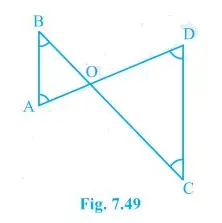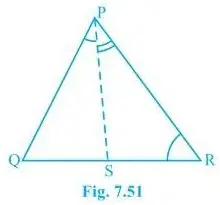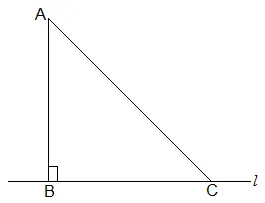Exercise: 7.4 (Page No: 132)
1. Show that in a right-angled triangle, the hypotenuse is the longest side.

Solution:
It is known that ABC is a triangle right angled at B.
We know that,
A +B+C = 180°
Now, if B+C = 90° then A has to be 90°.
Since A is the largest angle of the triangle, the side opposite to it must be the largest.
So, AB is the hypotenuse which will be the largest side of the above right-angled triangle i.e. ΔABC
.2. In Fig. 7.48, sides AB and AC of ΔABC are extended to points P and Q respectively. Also, PBC < QCB. Show that AC > AB.

Solution:
It is given that PBC < QCB
We know that ABC + PBC = 180°
So, ABC = 180°-PBC
Also,
ACB +QCB = 180°
Therefore ACB = 180° -QCB
Now, since PBC < QCB,
∴ ABC > ACB
Hence, AC > AB as sides opposite to the larger angle is always larger.
3. In Fig. 7.49, B < A and C < D. Show that AD < BC.

Solution:
In the question, it is mentioned that angles B and angle C is smaller than angles A and D respectively i.e. B < A and C < D.
Now,
Since the side opposite to the smaller angle is always smaller
AO < BO — (i)
And OD < OC —(ii)
By adding equation (i) and equation (ii) we get
AO+OD < BO + OC
So, AD < BC
4. AB and CD are respectively the smallest and longest sides of a quadrilateral ABCD (see Fig. 7.50).
Show that A > C and B > D.

Solution:
In ΔABD, we see that
AB < AD < BD
So, ADB < ABD — (i) (Since angle opposite to longer side is always larger)
Now, in ΔBCD,
BC < DC < BD
Hence, it can be concluded that
BDC < CBD — (ii)
Now, by adding equation (i) and equation (ii) we get,
ADB + BDC < ABD + CBD
ADC < ABC
B > D
Similarly, In triangle ABC,
ACB < BAC — (iii) (Since the angle opposite to the longer side is always larger)
Now, In ΔADC,
DCA < DAC — (iv)
By adding equation (iii) and equation (iv) we get,
ACB + DCA < BAC+DAC
⇒ BCD < BAD
∴ A > C
5. In Fig 7.51, PR > PQ and PS bisect QPR. Prove that PSR > PSQ.

Solution:
It is given that PR > PQ and PS bisects QPR
Now we will have to prove that angle PSR is smaller than PSQ i.e. PSR > PSQ
Proof:
QPS = RPS — (ii) (As PS bisects ∠QPR)
PQR > PRQ — (i) (Since PR > PQ as angle opposite to the larger side is always larger)
PSR = PQR + QPS — (iii) (Since the exterior angle of a triangle equals to the sum of opposite interior angles)
PSQ = PRQ + RPS — (iv) (As the exterior angle of a triangle equals to the sum of opposite interior angles)
By adding (i) and (ii)
PQR +QPS > PRQ +RPS
Thus, from (i), (ii), (iii) and (iv), we get
PSR > PSQ
6. Show that of all line segments drawn from a given point not on it, the perpendicular line segment is the shortest.
Solution:
First, let “l” be a line segment and “B” be a point lying on it. A line AB perpendicular to l is now drawn. Also, let C be any other point on l. The diagram will be as follows:

To prove:
AB < AC
Proof:
In ΔABC, B = 90°
Now, we know that
A+B+C = 180°
∴ A +C = 90°
Hence, C must be an acute angle which implies C < B
So, AB < AC (As the side opposite to the larger angle is always larger)